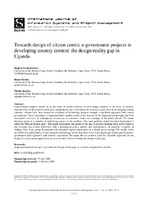Towards design of citizen centric e-government projects in developing country context: The design-reality gap in Uganda

View/
Date
2019Author
Kyakulumbye, Stephen
Pather, Shaun
Jantjies, Mmaki
Metadata
Show full item recordAbstract
E-government projects should be at the heart of service delivery in developing countries if the lives of citizens,
especially the socially and economically marginalized, are to be improved. However, quite often in developing country
contexts, citizens have been treated as recipients of technology projects through a top-down approach from central
governments. Such a paradigm of implementation usually results in the non-use of the deployed technologies and their
associated e-services. A consequence of non-use of e-services results in a wastage of the public fiscus. The extant
literature points to a number of underlying causes of the problem. One such problem which has been highlighted is
called the “Design-Reality gap”. This paper investigates the nature of the gap. It presents findings from policy analysis
and in-depth face-to-face interviews with e-government policy makers and implementers. In addition, it reports on
findings from focus group discussions with potential e-government users in a health sector setting. The results which
are based on a participatory action research methodology reveal that there exists a glaring design-reality gap between egovernment policy planners and citizens’ aspirations. We argue that co-creation could be a feasible approach for the
design of e-government application services towards efforts to bridge the design-reality gap.
